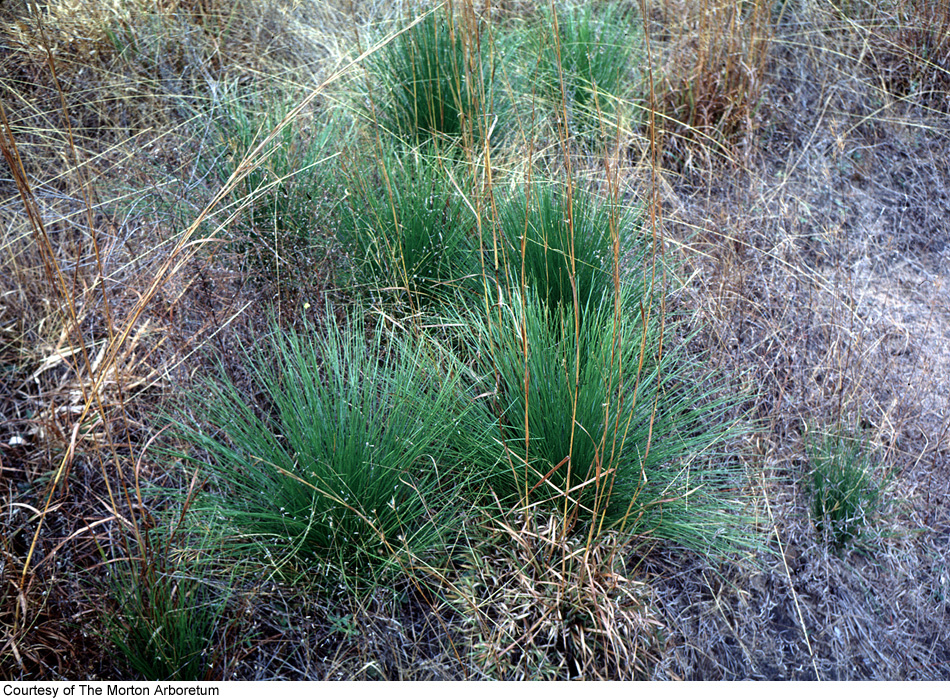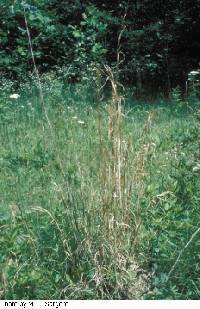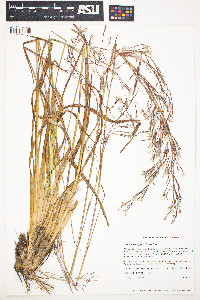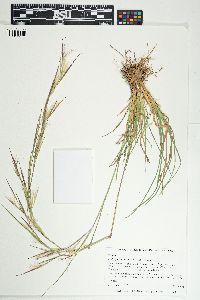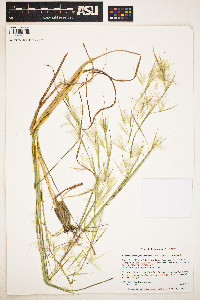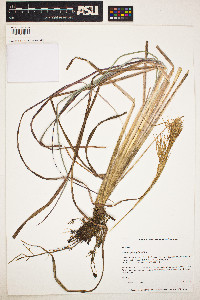|
Family: Poaceae
broomsedge bluestem, more...broomsedge bluestem, chalky bluestem [ Anatherum virginicum Spreng., moreAndropogon capillipes Nash, Andropogon virginicus var. decipiens C.S.Campb., Andropogon virginicus var. glaucus Hack., Andropogon virginicus var. tetrastachyus (Elliott) Hack.] |
Plants cespitose, dense and cylindrical to obpyramidal above. Culms
40-210 cm; internodes glaucous or not; branches erect to ascending,
usually straight, sometimes arching. Sheaths usually smooth, rarely somewhat
scabrous; ligules 0.2-1 mm, ciliate, cilia 0.2-1.3 mm; blades
11-52 cm long, 1.7-6.5 mm wide, smooth and glabrous or sparsely to densely pubescent
with spreading hairs. Inflorescence units 6-195 per culm; subtending
sheaths (2.1)3.1-4.6(6.7) cm long, (1.7)3-3.8(5.6) mm wide; peduncles
usually (1)4-6(30) mm, with 2-7 rames; rames (0.5)1.7-2.8(4.4) cm, sometimes
exserted at maturity, pubescence sparse basally and increasing in density distally
within each internode. Sessile spikelets (2.6)3.5-3.8(4.7) mm; callus
hairs 1-3 mm; keels of lower glume usually smooth below midlength,
scabrous distally; awns 6-21 mm; anthers 1(3), 0.6-1.5 mm, yellow
or purple. Pedicellate spikelets vestigial to absent. 2n = 20.
Andropogon virginicus is native from the southeastern United States to
northern South America, but has become established outside its native range in California, Hawaii, Japan, and Australia.
Three varieties are recognized, two of which contain morphologically distinct
variants. Andropogon virginicus hybridizes with A.
glomeratus and A. longiberbis
(Campbell 1986). Perennial densely tufted herb 40 cm - 2.15 m tall Leaves: with often smooth sheaths and ligules that are 0.2 - 1 mm long, membranous, and lined with hairs (0.2 - 1.3 mm long) along the margins. The blades are linear, 11 cm - 0.52 m long, 1.7 - 6.5 mm wide, hairless or with spreading hairs. Inflorescence: terminal and axillary, with numerous clusters per culm and two to seven spikes per cluster. The hairy spikes are 0.5 - 4.4 cm long and the base is sometimes surrounded by the subtending sheath. Fruit: a caryopsis. Culm: erect, highly branched above, 40 cm - 2.1 m tall, the internodes sometimes covered with a whitish waxy coating (glaucous). Spikelets: either stalkless or stalked. The stalkless spikelets are bisexual and 2.6 - 4.7 mm long, and the stalked spikelets are absent or rudimentary. Florets: of the stalkless spikelets have a lemma with an awn 6 - 21 mm long and one (rarely three) yellow or purple anther 0.6 - 1.5 mm long. Lower glume: membranous, with unwinged longitudinal ridges that are usually smooth below the middle and rough above. Similar species: Both Andropogon gerardii and A. hallii have inflorescences longer than 5 cm, well-developed stalked spikelets, and three anthers per floret. Flowering: August to October Habitat and ecology: Introduced from the southern United States, this species is a weed in old sandy fields. Occurence in the Chicago region: non-native Etymology: Andropogon comes from the Greek words aner, meaning man, and pogon, meaning beard. Virginicus means "from Virginia." Author: The Morton Arboretum Culms tufted, 5-15 dm, branched above, mostly glabrous and often glaucous, the uppermost nodes sometimes sparsely villous; lvs often pilose on the sheath and ligule, the blade 3-8 mm wide; uppermost lvs spathe-like, enclosing the short (2-10 mm) peduncle and base of the few-many paired racemes, these 2-3 cm, with slender, flexuous, long-villous rachis; fertile spikelet 3-5 mm, shorter than the long-villous sterile pedicel, but longer than the internode just above it, the straight awn 1-2 cm; stamen mostly solitary; sterile spikelet none, or a delicate narrow glume to 2 mm; 2n=20. Our two principal vars. are very distinct northward, but pass freely into each other along the coastal plain from Md. southward through a series of intermediate forms often called var. glaucopsis (Elliott) Hitchc. Typical material differs as follows:
Gleason, Henry A. & Cronquist, Arthur J. 1991. Manual of vascular plants of northeastern United States and adjacent Canada. lxxv + 910 pp.
©The New York Botanical Garden. All rights reserved. Used by permission. |

